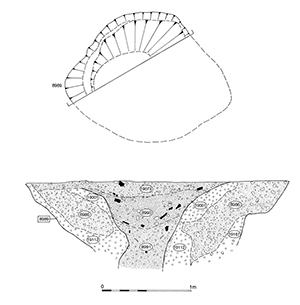
As Building 31 and its associated Structure 30 sub-enclosure pass out of use during Period 3, presumably by the 2nd century, the later Period 3 features occupying OA25 are collectively described without separation between the east and west sides of the enclosure (Figure 99). Building 32 is not significantly encroached upon in the first half of the 2nd century and it remains uncertain whether or not it survives this late.
The identified mid-2nd century pits within OA25 are largely restricted to its east side. This, however, may merely be a product of the excavation strategy. It is noted that Building 31 is encroached upon by one such pit, which may suggest that their spread becomes more uniform across the enclosure once the building passes out of use.
The excavated later Period 3 pits comprise two very large irregular examples 8866/8700 and 19149 (Group 658), in excess of 4m diameter, and several smaller ones ranging between 1.3m and 1.8m.
Of the larger pits, 19149 has a varied pottery assemblage, ranging in date from the 1st to 4th centuries AD; its apparently homogeneous fills perhaps masking a number of episodes of accumulation and/or re-cutting taking place during the late 2nd/mid-3rd centuries. It also contains quantities of tile, tessera, mortar, slag and an iron horse bit link (SF7384). It is likely that it accumulated material into Period 4.
The smaller pits (8511, 8716, 8750, 19138, Group 659) are generally scattered across the southern part of OA25. Pits 8515 and 8654 (Group 661) are in reality part of this distribution, but are distinguished here because they post-date Structure 34, the former being demonstrated to cut its northern wall foundation while the latter is inferred to impinge upon the southern wall. Most contain small amounts of pottery and tile, with occasional animal bone and ironwork. Although otherwise undistinguished, pit 8750 is notable for its relatively large and varied finds assemblage that includes a ceramic disc (SF7389).
Early/mid-2nd century pit 11092 (Group 667) cuts the north-western corner of Building 31, clearly showing that it passes out of use during Period 3. The large, sub-circular and steep-sided cut contains a relatively complex fill sequence. Initial silts are apparently capped or consolidated with gravel and cobbles and overlain with a clay lining; rubbish-rich silts, primarily pottery and tile, infill the remainder. Although much of the pottery appears to be residual Late Iron Age, the presence of later material, including a B2/B4 dish and mortarium, suggests 11092 is filled closer to the middle of the 2nd century. It could perhaps be regarded as a re-cut or replacement of pit 11093.

Well 8989 is a large, sub-circular, cut of 3m diameter. Its steeply sloped sides drop to a sub-square central shaft 1.1m square (Figure 124). Both cone and shaft contain clay lining deposits (19112, 19167). Although not excavated below the modern water-table, it clearly continues to greater depth. No evidence of a wooden lining is encountered. The well is constructed in early/mid-2nd century, judging by the pottery in construction cut backfill 8986. It is probably in use until at least the late 2nd century, during which time a number of repairs are carried out to the clay lining following collapse and rebuilding of the upper part of the well. The backfill deposits date to Period 4.
The location of this well, immediately to the south of Period 2B Building 32, might suggest that the building still stands and functions at the time of the well's construction, though this would place it rather close to the base of the wall. However, perhaps the post-built south room need not exist by this time. Even if Building 32 does not survive this late, the presence of a well at least suggests the continued occupation of the enclosure.
Although located on wall-lines of the building, cuts 8690 and 8702 (Group 215) seem too large to be post-holes per se. They may represent robbing actions after the disuse of the building or post-date it completely, but could at least hint at the former positions of some of its structural uprights.
Internet Archaeology is an open access journal based in the Department of Archaeology, University of York. Except where otherwise noted, content from this work may be used under the terms of the Creative Commons Attribution 3.0 (CC BY) Unported licence, which permits unrestricted use, distribution, and reproduction in any medium, provided that attribution to the author(s), the title of the work, the Internet Archaeology journal and the relevant URL/DOI are given.
Terms and Conditions | Legal Statements | Privacy Policy | Cookies Policy | Citing Internet Archaeology
Internet Archaeology content is preserved for the long term with the Archaeology Data Service. Help sustain and support open access publication by donating to our Open Access Archaeology Fund.